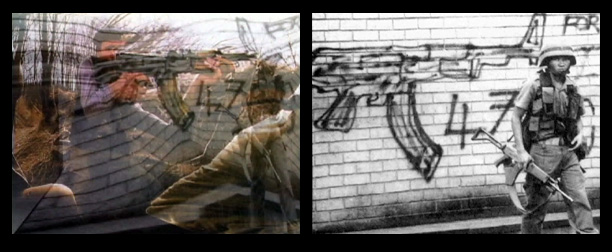
- 1502 Alabama St.
- Houston, TX 77004
- USA
- 713-529-6900
- station.museum.houston.tx@gmail.com
- Closed Monday & Tuesday
- Open Wednesday - Sunday, 12PM - 5PM
- Free Admission!

(JÁNOS SUGÁR – Hungary)
The general history of the machine gun is interesting. When engineering helpfully solved the technical problem of a fast killing machine, it was considered so immorally savage that for a while it was used only in the colonies, just as at the end of WWI the machine gun was used at the European battlefields. The analogies of the machine gun to the film camera are also obvious. Paul Virilio writes about this in his famous War and Cinema. Now the infamous AK 47 (later AKM) is a fetish, a cult object object, and a successful design piece. Right beside the Jaguar E Type, the Kalashnikov should be on display in the New York Museum of Modern Art, and in an instant with these two objects (the AK-47 and the Jaguar) we depicted the 20th Century. The technical specialty of the AKM is its simplicity and efficiency. It has only a few parts; even a village blacksmith could repair it. But its other specialty is maybe more important: as a part of the Soviet power politics, it was licensed to clone, as the IBM PC; it was produced in twenty countries (including Denmark, Sweden, Finland, Italy, Israel, Egypt) and the Kalashnikov made a bloody carrier as the poorest people’s master key to the history. The Soviets discovered the distribution of unrest. Need a gun? Here you are. Like selling drugs in front of a school. With a single loading one can kill twenty people, and in societies where ambitions cannot have other safety valves, it is an option for expressing oneself. In Uganda you can have an AK-47 for a chicken, in Angola for a sack of rice. It is the Esperanto of aggression. Aggression is a status symbol, even in the poorest countries. Somalians have a familiar proverb: “I and Somalia against the world, I and my clan against Somalia, I and my family against the clan, I and my brother against the family, I against my brother.” Around 50 million AKMs are in use around the globe.
János Sugár

János Sugár, video stills: “TYPEWRITER OF THE ILLITERATE”, 2001, digital video, 7 minutes 18 seconds
